Plan on using your CPAP each night and consider using it while you nap as well. Obstructive Sleep Apnea is not cured by CPAP. CPAP treatment only provides relief of symptoms. Each time you sleep without your CPAP, your OSA is untreated. You should take your machine with you when you travel too.
Who pays for CPAP therapy in Quebec?
Private health insurance typically covers 80-100% of CPAP therapy. CPAP therapy in Quebec is not covered by public health (RAMQ). Quebecers receiving welfare benefits are eligible for CPAP therapy. Apnea Health will help you submit all the necessary forms to your insurance company or to Centre Locale de l’Emploi (welfare agency).
Is CPAP noisy?
The newer devices are very quiet, so it is rare to encounter noise problems. If you have an old CPAP model, please consult your health insurance company as you may be eligible for a new CPAP. Generally, health insurance policies allow coverage of one CPAP unit every five years and one mask every year.
How long does it take to get used to CPAP?
Most patients will require a period of adjusting to the presence of the CPAP mask on the face and the feel of the air pressure delivered by the CPAP unit. The time of this adjustment is variable – anywhere from a few days to a few weeks and in rare cases, some patients take several months to adjust to CPAP. Apnea Health offers a flexible trial period to help you adapt to CPAP therapy.
How quickly after starting CPAP therapy will I feel less tired?
It varies from person to person, some feel immediate improvements, others take a while longer. Your sleep apnea severity also plays a role in this.
Should I use my CPAP when I have a cold?
Yes, it’s a good idea to try to continue your CPAP therapy. If you continue CPAP therapy, you may be able to keep your sleep apnea symptoms in check, giving you more energy to fight the cold.
Here are a few helpful tips:
- Elevate your head
- Ensure you are using a heated humidifier
- Use nasal decongestant
- If you have a full face mask, use it so you can breathe from your mouth
Can I travel with my CPAP?
Customs agents and airline personnel are familiar with CPAP devices. Always carry your CPAP with you on the airplane; do not place it in checked baggage. It is recommended to keep a copy of your prescription in your CPAP’s transport bag.
What do I do if I experience nasal congestion?
Nasal congestion can be caused by different factors such as allergies, a cold, a flu or even a dry environment. It is recommended to increase the humidity setting on the humidifier of your CPAP in order to clear out your nose. It is normal to frequently change the humidifier setting until you find your comfort level. If the congestion is due to severe allergies, please see your doctor as they may be able to prescribe a steroid based nasal vaporizer. Another option for those with chronic sinus and nasal issues would be a nasal irrigator. This flushes out the sinuses with a salt solution, helping to reduce inflammation, moisturise the passages and clear blockages and congestion.
What do I use to clean my mask, CPAP and water chamber?
Please see our complete cleaning resource section. CPAP Cleaning Instructions Page
What can I do to prevent air leaking from my mask?
Simply adjusting the headgear may solve the problem. However, you may also be opening your mouth during your sleep. In this case, you may require a full-face mask or a chin strap, which can help keep your mouth closed. Leakage can also be the result of a mask that needs replacement. When a mask becomes old, it no longer holds a proper seal.
How do I adapt to wearing a mask if I am claustrophobic?
It would be a good idea to wear the mask for a couple of days before hand. You can try your CPAP (with mask) in an elevated position or standing up. Next step would be to lie down while staying awake; do not fall asleep until you are perfectly comfortable. Once you feel at ease with your mask you can start sleeping with it and you will have beaten your claustrophobia.
How often should I replace the CPAP parts?
In order to maintain the proper hygiene of your equipment, please refer to the following recommendation. Also, most private insurance cover the accessories of your CPAP on a yearly basis.
| ITEM | FREQUENCY |
| Mask | 8-12 months |
| Water Chamber | Yearly |
| Tubing | Yearly |
| Filters | Quarterly |
What is heated tubing?
Heated CPAP tubing contains copper coils that are gently heated to conduct a constant temperature throughout the length of the hose. This enhances the comfort of the therapy and reduces or eliminates rainout (the accumulation of water in a CPAP tube due to warm moist air cooling and condensing on its way from your CPAP machine to your CPAP mask).
Why does water accumulate in the tube?
This is due to the difference in temperature between the room and inside your tube, which causes condensation and water build up in tube. If you sleep with a window open causing it to be cold in your room, you may need a cover for your tube or a heated tube.
What problems can occur while I am using CPAP?
- Nasal stuffiness, congestion, or dryness
- Dry mouth
- Mask air leaks
- Sore, dry or red eyes
- Skin irritation from the mask and/or air
- Sensation of too much air in the chest
- Sensation of abdominal bloating, cramping or gas
- Persistent sleepiness despite regular use of CPAP
- Feeling claustrophobic with the mask
- Waking up having taken the mask off
These problems should be addressed with our respiratory therapist who can help alleviate any issues/discomfort
I’ve lost some weight. Do I still have sleep apnea?
Weight is an important factor in obstructive sleep apnea. There’s no guarantee weight loss, in itself, is going to clear up sleep apnea; however, a large weight decrease may affect your required CPAP pressure. The best thing to do is to advise us of a weight gain/loss of 20lbs or more.
Do I need to wear my CPAP every night?
What happens if I stop CPAP treatment?
If you stop using CPAP, your sleep apnea symptoms may come back. The CPAP treatment only works when you use it. Cessation of the treatment can also pose risks to your health such as hypertension, stroke, diabetes, depression and cardiovascular diseases.
Virtual Home Sleep Test
You needn’t visit the clinic to be tested for sleep apnea
Virtual CPAP Treatment
All instruction is provided by online video conferencing
Our New Shopify Store
Take advantage of reduced pricing on all our products!
Remote Care Consultations
Consult our professionals through TELEMEDICINE
Care for Life
More affordable without compromising on service



